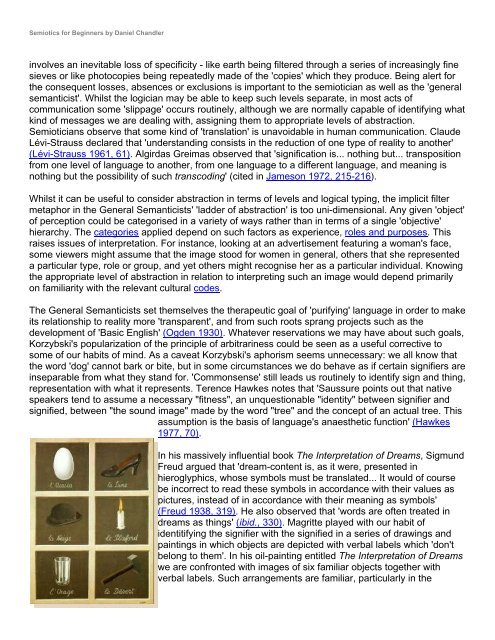Semiotics for Beginners by Daniel Chandler
Semiotics for Beginners by Daniel Chandler
Semiotics for Beginners by Daniel Chandler
You also want an ePaper? Increase the reach of your titles
YUMPU automatically turns print PDFs into web optimized ePapers that Google loves.
<strong>Semiotics</strong> <strong>for</strong> <strong>Beginners</strong> <strong>by</strong> <strong>Daniel</strong> <strong>Chandler</strong><br />
involves an inevitable loss of specificity - like earth being filtered through a series of increasingly fine<br />
sieves or like photocopies being repeatedly made of the 'copies' which they produce. Being alert <strong>for</strong><br />
the consequent losses, absences or exclusions is important to the semiotician as well as the 'general<br />
semanticist'. Whilst the logician may be able to keep such levels separate, in most acts of<br />
communication some 'slippage' occurs routinely, although we are normally capable of identifying what<br />
kind of messages we are dealing with, assigning them to appropriate levels of abstraction.<br />
Semioticians observe that some kind of 'translation' is unavoidable in human communication. Claude<br />
Lévi-Strauss declared that 'understanding consists in the reduction of one type of reality to another'<br />
(Lévi-Strauss 1961, 61). Algirdas Greimas observed that 'signification is... nothing but... transposition<br />
from one level of language to another, from one language to a different language, and meaning is<br />
nothing but the possibility of such transcoding' (cited in Jameson 1972, 215-216).<br />
Whilst it can be useful to consider abstraction in terms of levels and logical typing, the implicit filter<br />
metaphor in the General Semanticists' 'ladder of abstraction' is too uni-dimensional. Any given 'object'<br />
of perception could be categorised in a variety of ways rather than in terms of a single 'objective'<br />
hierarchy. The categories applied depend on such factors as experience, roles and purposes. This<br />
raises issues of interpretation. For instance, looking at an advertisement featuring a woman's face,<br />
some viewers might assume that the image stood <strong>for</strong> women in general, others that she represented<br />
a particular type, role or group, and yet others might recognise her as a particular individual. Knowing<br />
the appropriate level of abstraction in relation to interpreting such an image would depend primarily<br />
on familiarity with the relevant cultural codes.<br />
The General Semanticists set themselves the therapeutic goal of 'purifying' language in order to make<br />
its relationship to reality more 'transparent', and from such roots sprang projects such as the<br />
development of 'Basic English' (Ogden 1930). Whatever reservations we may have about such goals,<br />
Korzybski's popularization of the principle of arbitrariness could be seen as a useful corrective to<br />
some of our habits of mind. As a caveat Korzybski's aphorism seems unnecessary: we all know that<br />
the word 'dog' cannot bark or bite, but in some circumstances we do behave as if certain signifiers are<br />
inseparable from what they stand <strong>for</strong>. 'Commonsense' still leads us routinely to identify sign and thing,<br />
representation with what it represents. Terence Hawkes notes that 'Saussure points out that native<br />
speakers tend to assume a necessary "fitness", an unquestionable "identity" between signifier and<br />
signified, between "the sound image" made <strong>by</strong> the word "tree" and the concept of an actual tree. This<br />
assumption is the basis of language's anaesthetic function' (Hawkes<br />
1977, 70).<br />
In his massively influential book The Interpretation of Dreams, Sigmund<br />
Freud argued that 'dream-content is, as it were, presented in<br />
hieroglyphics, whose symbols must be translated... It would of course<br />
be incorrect to read these symbols in accordance with their values as<br />
pictures, instead of in accordance with their meaning as symbols'<br />
(Freud 1938, 319). He also observed that 'words are often treated in<br />
dreams as things' (ibid., 330). Magritte played with our habit of<br />
identitifying the signifier with the signified in a series of drawings and<br />
paintings in which objects are depicted with verbal labels which 'don't<br />
belong to them'. In his oil-painting entitled The Interpretation of Dreams<br />
we are confronted with images of six familiar objects together with<br />
verbal labels. Such arrangements are familiar, particularly in the




